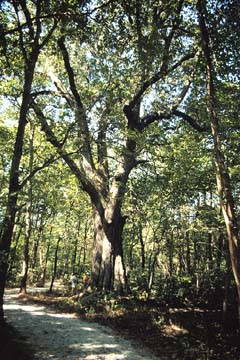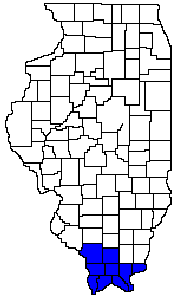 |
| Cherrybark
Oak (Quercus pagoda)
Distribution
Map to Right |

Cherrybark oak grows to heights of 100 feet. Its trunk is straight, and reaches a diameter of up to 4 feet. The crown is rounded. Cherrybark oak grows only in the southernmost portions of Illinois on bottomlands or along riverbanks.
Interesting
Facts
Cherrybark
oak is often classified as a variety of Spanish oak (Quercus falcata),
but the two trees differ in several important ways. Cherrybark oak occurs
on moist sites, in bottomlands, for example, but Spanish oak typically
occurs in drier uplands and on sites with poor soil. Spanish oak occurs
only occasionally in bottomlands. The Spanish oak has a 5 lobed leaf whereas
the Cherrybark oak has 5 to 7 lobes. The Spanish oak is the only bristle-tipped
Illinois oak that has a fine mat of hairs on the underside of the leaf.
The species name, pagoda refers to the appearance of the leaf when it is viewed with the leaf tip pointed towards the ground. Looking at the leaf from this perspective, the angle of the lobes resembles the overlapping roofs of an oriental pagoda.
Identifying Features
BarkUses
Cherrybark oak is in the red oak group. The bark is gray and has scaly, narrow ridges.
Twigs
The twigs are thick and brown or gray, hairy when young.
Buds
The buds are egg-shaped with a pointed at the tip, angular, and hairy.
Leaves
The leaves are alternate, simple and have 5 to 11 bristle-tipped lobes which are deeply incised (indented at least half way to the mid-rib of the leaf, and sometimes almost completely to midrib). Leaves are 7 to 10 inches long and up to 7 inches wide, dark green, smooth, and shiny on the surface, and paler and hairy on the underside.
Flowers
Male and female flowers occur separately on the same tree, and appear at leafout. Males are drooping clusters of catkins and females are tiny, without petals and occur in small groups.
Fruits
Acorns are either single or in pairs and require two years to mature, ripening in the fall. They are about 1/2 inch long, light orange-brown, and shaped like a child's top, with a pointed end. The cup covers about 1/3 of the nut and has fine hairs. Songbirds, game birds, mice, and deer eat the acorns.
Cherrybark oak wood is heavy, hard, and coarse grained. It is used for fence posts, interior finishing, veneer, general construction, furniture, and cabinets. It is light reddish brown. Native Americans used cherrybark oak in a variety of ways to treat ailments ranging from indigestion and lost voice, to asthma and milky urine.